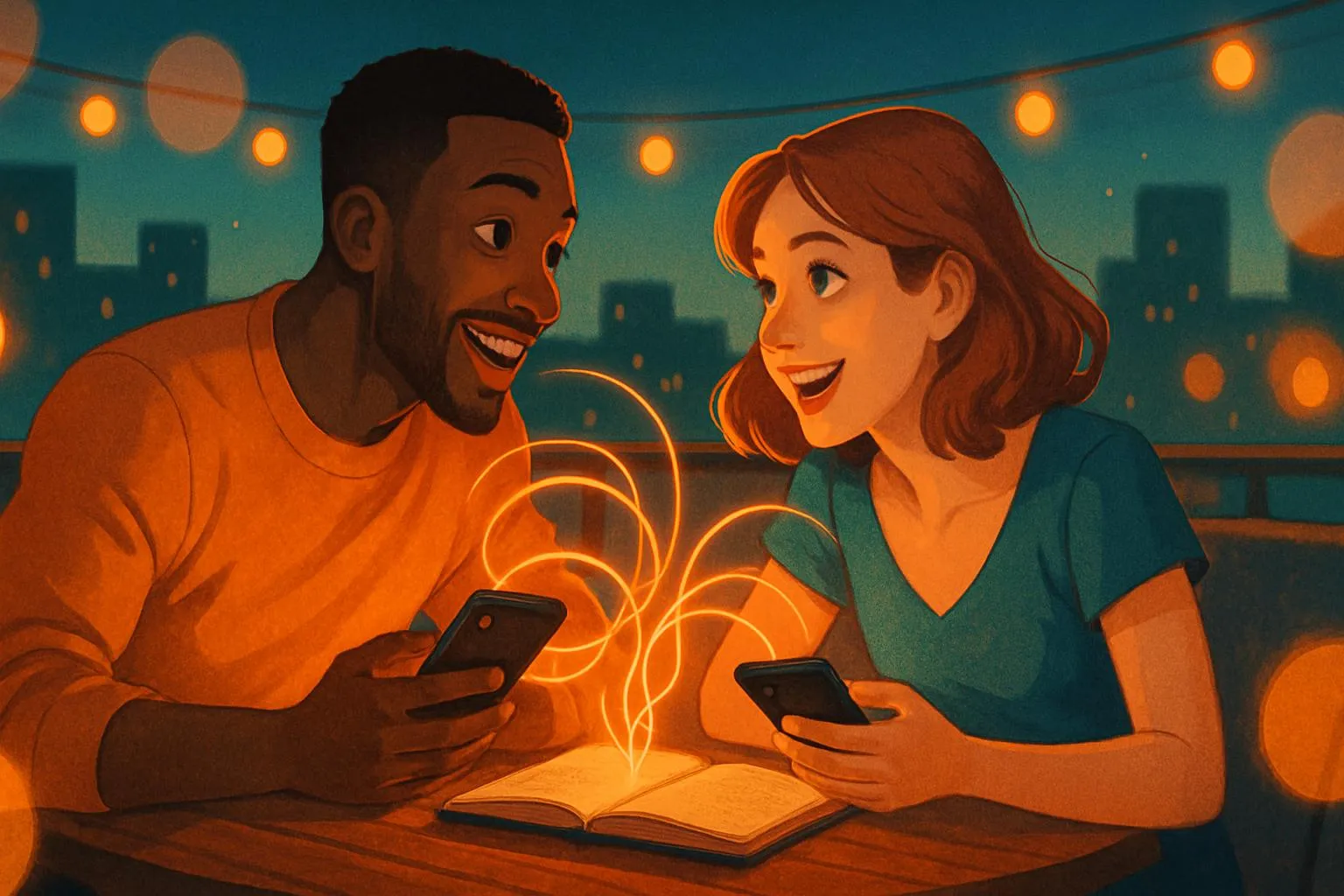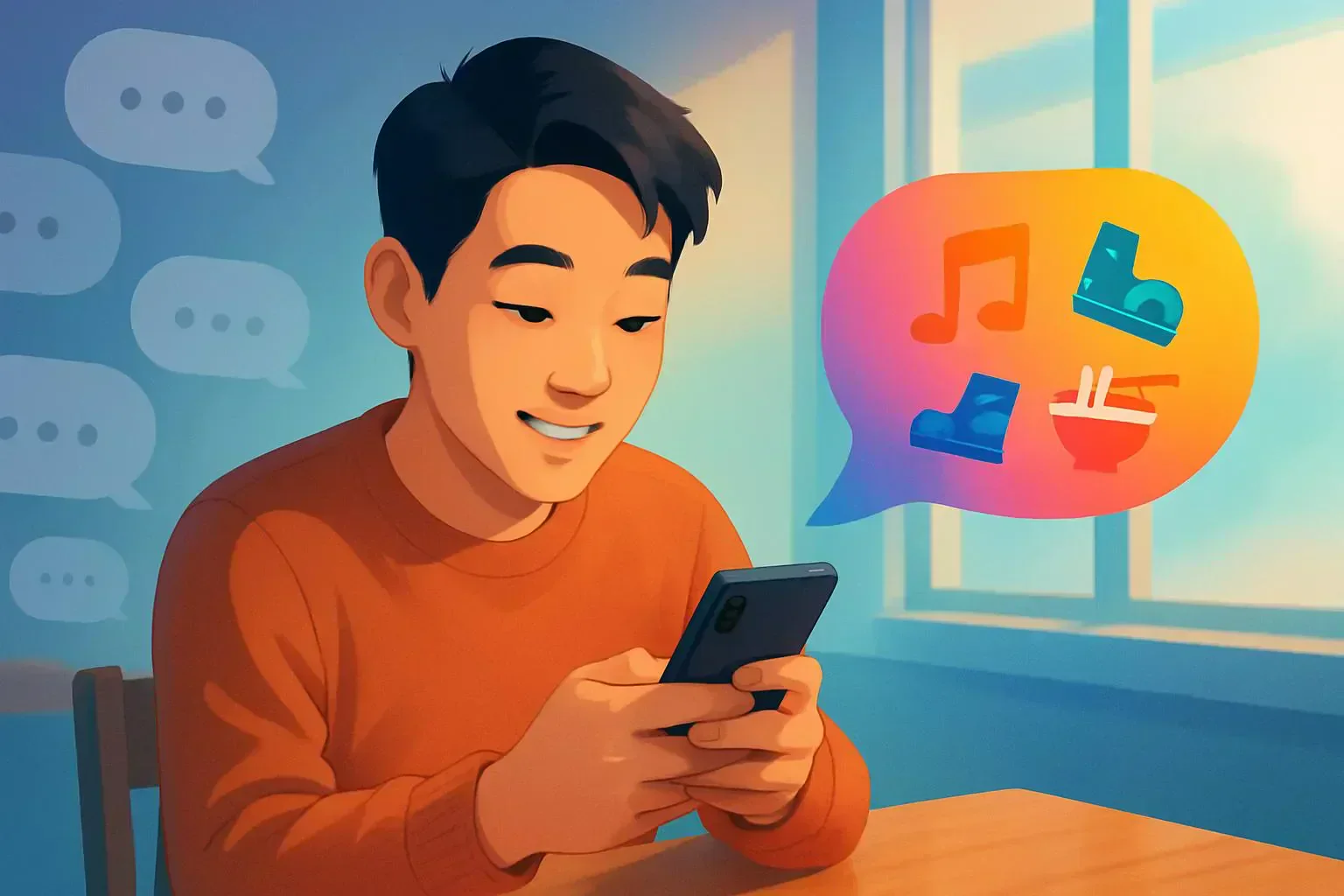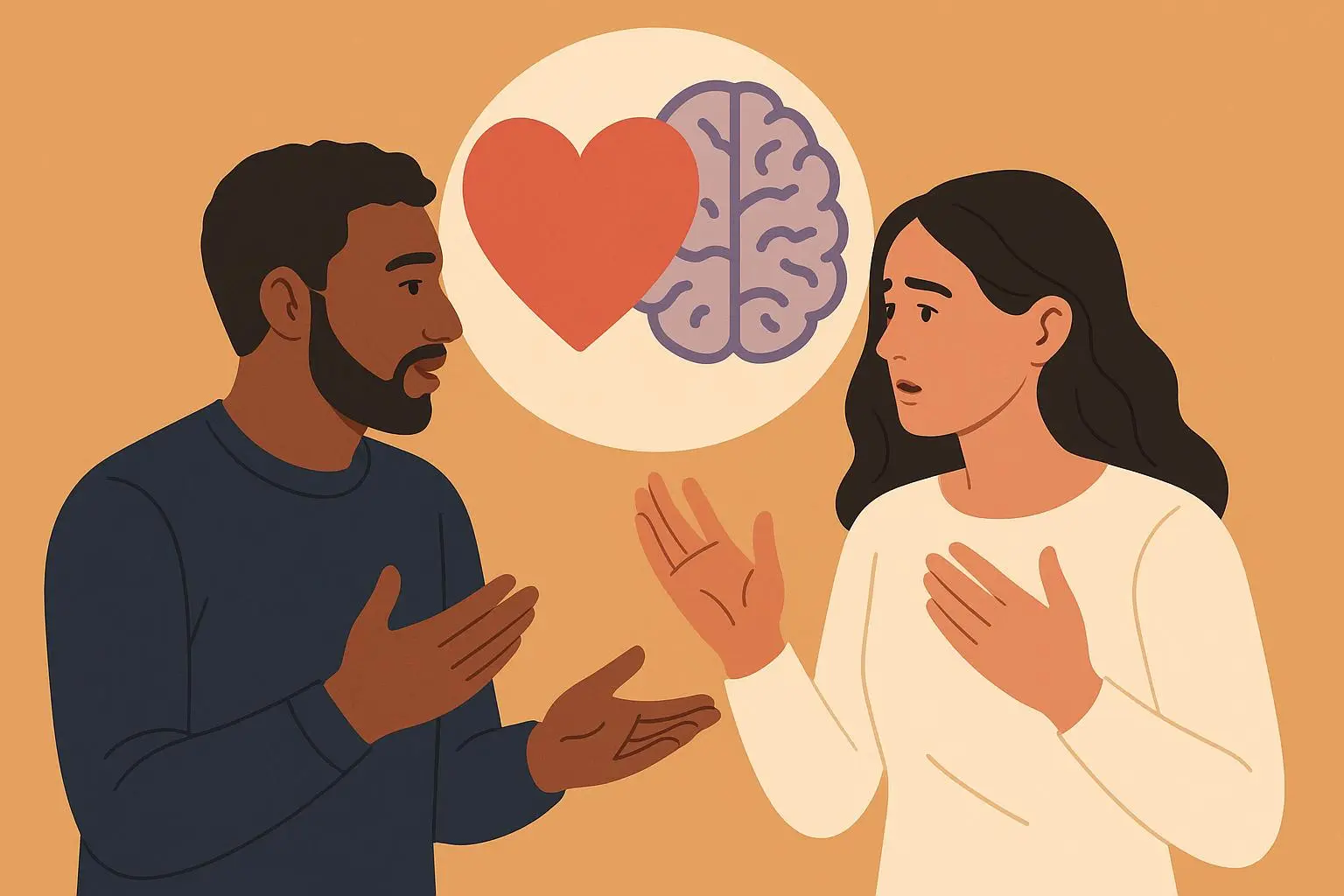
How to Keep Dating App Conversations Alive Past the Awkward Small Talk Phase
Published on 11/3/2025 • 10 min read
You matched with someone intriguing. Three days ago, they were sending paragraph-long messages about their obsession with sourdough baking. Now? Radio silence. The conversation's deader than your gym membership after February.
Here's the thing nobody tells you about dating apps: most conversations die. Not because you're boring or undateable, but because everyone's juggling 5-10 conversations simultaneously while also trying to remember if they fed their cat. The difference between people who succeed on dating apps and those who don't isn't luck—it's knowing exactly how to breathe life back into a dying conversation without coming across like you're auditioning for their attention.
Why Conversations Actually Die (And It's Not Always Your Fault)
Before you start crafting the perfect resurrection message, let's get real about why matches ghost in the first place. Research on dating app behavior shows that the average user has between 3-12 active conversations at once. Your match isn't necessarily uninterested—they might be genuinely overwhelmed, distracted by a work crisis, or simply forgot to respond after their friend interrupted mid-type.
Sometimes the conversation dies because it hit a natural lull. You exchanged the basics: job, location, that funny story about your coworker. Then what? The small talk well runs dry, and neither person knows how to transition to something more meaningful.
Other times, your last message didn't invite a response. "Haha yeah" and "that's cool" are conversation killers disguised as acknowledgments. They're the textual equivalent of a dead end—nowhere to go from there.
The brutal truth: Dating app fatigue is real. Users report feeling burned out by the constant need to be witty, engaging, and available. This creates an environment where even promising connections get abandoned simply because maintaining momentum feels exhausting.
The First Message Isn't Your Biggest Hurdle
Here's what surprises people: the first message isn't where most connections fail. It's messages three through seven where genuine connections either catch fire or fizzle out completely. After analyzing thousands of dating app exchanges, a clear pattern emerges: conversations that lead to actual dates share specific characteristics that most people accidentally sabotage without realizing it.
Research on successful dating conversations shows a clear divide. Connections that translate to real dates involve discussions about feelings, experiences, passions, and observations rather than basic biographical data exchanges. When someone asks "How's your day going?" they're essentially asking you to perform emotional labor without giving you anything interesting to work with.
The conversations that survive past message five share something crucial: they make the other person feel something. Understood, intrigued, amused, curious, or even playfully challenged. Biographical questions make people feel like they're filling out a form. And who wants to date a DMV employee?
Shift from Gathering Information to Sharing Observations
Maya Angelou said it best: "People will forget what you said, people will forget what you did, but people will never forget how you made them feel." This applies perfectly to dating apps. Your match won't remember that you asked about their job. They will remember if you made them laugh, feel understood, or experience a moment of genuine connection.
Instead of asking "What do you do for work?" try "What's the most unexpected thing about your job?" Instead of "Where are you from?" ask "What's something people always get wrong about where you grew up?"
Better yet, weave statements into your questions. Share something about yourself, then invite them to do the same:
"I'm convinced that pineapple on pizza is a hill I'm willing to die on—where do you stand on controversial food opinions?"
See the difference? You're having a conversation, not conducting an intake form.
The 72-Hour Rule for Revival Messages
Timing isn't everything, but it's definitely something. Send a follow-up too soon, and you risk looking desperate or pushy. Wait too long, and your match has either moved on or forgotten who you are entirely.
The sweet spot? 48 to 72 hours after their last message. This gives them enough time to realize they haven't responded without making it seem like you've been counting the hours (even if you have). If it's been longer than five days, you'll need a stronger opening that acknowledges the gap rather than pretending it didn't happen.
One exception to this rule: if the conversation died on a weekend, wait until Tuesday or Wednesday to revive it. Monday is when everyone's drowning in work catch-up, and weekend messages often get buried under social plans. Mid-week messages have significantly higher response rates because people are settled into their routines and more likely to engage with their apps during downtime.
Five Conversation Revival Techniques That Actually Work
1. The Callback Method
Remember something specific they mentioned earlier? Reference it. "Hey, did your sister end up loving that restaurant you recommended?" or "How did that presentation you were stressing about go?"
This approach works because it proves you were actually listening, not just waiting for your turn to talk. It transforms your follow-up from "just checking in" to "I remembered this detail about your life and care about the outcome." That distinction matters more than you think.
2. The Humble Acknowledgment
Sometimes honesty is the best strategy. "I realized my last message didn't really give you much to work with—that's on me. Want to try this again?"
The key here is taking responsibility without being self-deprecating to the point of cringe. You're not apologizing for existing; you're simply acknowledging that the conversation lost momentum and you'd like to find it again. This shows emotional intelligence and self-awareness—both attractive qualities.
3. The Pattern Interrupt
If your previous messages were all questions or all statements, switch it up completely. Share something unexpected: a random observation, a funny thing that happened, or an opinion on something you haven't discussed yet.
"Okay, controversial opinion: breakfast foods are wildly overrated. Defend pancakes or tell me I'm right."
This works because it breaks the predictable back-and-forth pattern. The human brain is wired to notice changes and anomalies. A sudden shift in conversation style can jolt someone out of autopilot mode and make them actually want to engage.
4. The Choice Question
Give them two specific options instead of an open-ended question. "Quick poll: are you team 'pineapple belongs on pizza' or team 'that's a crime against Italy'?"
Binary choices require less cognitive effort to respond to than "How was your weekend?" The psychology here is fascinating—open-ended questions, while seeming more thoughtful, actually create decision fatigue. When someone's already managing multiple conversations, reducing the mental load of responding increases your chances of getting a reply.
5. The Media Share
Send a meme, article, video, or song with brief context: "This reminded me of what you said about your roommate's cooking disasters" or "Found this and immediately thought you'd appreciate it."
The media does the heavy lifting while the personal connection shows you're thinking about them. Visual content has significantly higher engagement rates than text-only messages. It gives them something to react to that doesn't require crafting a thoughtful response from scratch.
What Never to Send (The Desperation Red Flags)
Let's talk about what doesn't work. Multiple messages in a row without a response looks desperate, not interested. "Hey" followed by "You there?" followed by "Guess you're busy" reads like you're monitoring their activity status, which is honestly a bit creepy.
Passive-aggressive messages are relationship killers before the relationship even starts. "I guess you're too busy for dating apps?" or "Must be nice to have so many options you can just ignore people" will get you unmatched faster than you can say "I was just joking." Even if you're frustrated, that frustration isn't your match's problem to solve.
Generic conversation starters are another dead end. If your revival message could literally be sent to anyone—"Hey, how's your week going?"—why would they prioritize responding to you over the ten other people asking the same thing? Specificity shows effort, and effort signals interest.
When to Know It's Actually Over
Sometimes conversations die because they should. If you've sent two thoughtful follow-ups spaced appropriately apart and gotten nothing back, it's time to move on. Persistence past that point isn't romantic; it's ignoring clear signals.
Look for context clues in their profile activity. If they've updated their photos or bio but still haven't responded to you, they're active but choosing not to engage. That's your answer. If they've been completely inactive for weeks, they might have deleted the app or taken a break from dating entirely. Either way, the result is the same.
Remember that not every match is meant to become something more. Chemistry through text is different from chemistry in person, and sometimes people realize the connection isn't there before you do. That's not a reflection of your worth—it's just compatibility doing its job of filtering out mismatches early.
The Sweet Spot: Moving from Text to Reality
Here's something that surprises people: texting for too long before meeting actually decreases your chances of a successful date. There's a sweet spot of about 3-4 days of messaging before proposing to meet in person. Go longer than that, and conversations tend to get stale. People build up expectations that are hard to meet in real life, or the momentum just naturally fizzles out.
If you've successfully revived a dead conversation and things are flowing again, don't let momentum die a second time. Suggest a specific, low-pressure first date within a few days of reconnection:
"There's a coffee shop near me that makes ridiculous latte art. Want to check it out Saturday afternoon?"
The specificity reduces the decision-making burden, and the casual nature keeps pressure low. If they're genuinely interested, they'll either agree or propose an alternative. If they dodge the suggestion, you have your answer about whether this connection is worth pursuing.
How AI Can Actually Help (Without Being Creepy)
This is where things get interesting. Everything we've talked about—the conversation killers, the momentum destroyers, the unintentional red flags—they're all fixable. And sometimes, you need a little help seeing your blind spots.
That's where tools like Rizzman come in. Not to fake who you are or script your entire personality, but to help you understand what's working and what's not. Think of it as having a friend who's really good at texting look over your shoulder and say "maybe don't send that" or "here's a better way to phrase this."
The key is using AI assistance to enhance your communication skills, not replace them. You're not looking for someone to write your messages for you—you're looking for coaching that helps you become better at expressing yourself.
Good AI dating assistance helps you identify patterns you might not notice on your own. Maybe you tend to ask too many questions without sharing about yourself. Maybe your enthusiasm doesn't come through in text the way it does in person. Maybe you're accidentally ending conversations before they get started. Having that insight can genuinely improve your communication, not just in dating apps but in how you connect with people generally.
Practice Scenarios: Real Conversations, Real Solutions
Let's break down some actual dead conversation scenarios and how to revive them.
Scenario 1: You matched with someone who loves hiking. You exchanged a few messages about trails, then silence for four days after you asked "What's your favorite hike?"
Revival Strategy: Skip the generic follow-up. Instead try: "Okay, so I went down a rabbit hole of hiking videos last night, and now I'm convinced I need to do the Angel's Landing trail. Talk me out of it, or better yet, convince me it's worth the terror."
This shows continued interest in the shared topic while adding personality and inviting playful debate.
Scenario 2: The conversation started strong with witty banter about your mutual love of terrible reality TV, but fizzled after a day of rapid-fire messages. Three days of silence.
Revival Strategy: "Taking a break from our text marathon to actually ask: are you watching the new season of that show we talked about? Because I have THOUGHTS and need someone to process them with."
Acknowledges the pause without making it weird, references your connection point, and gives them an easy, specific thing to respond about.
Scenario 3: You matched with someone, exchanged a few polite messages, but never quite found your rhythm. The last exchange was them saying "That's interesting!" to your story about your job.
Revival Strategy: "Okay, starting over because I think we got stuck in interview mode. Rapid fire: coffee or tea? Morning person or night owl? Mountains or beach?"
This completely resets the dynamic, acknowledges the stiffness, and makes responding easy and fun.
Building Conversations That Don't Die in the First Place
The best way to revive dead conversations is to have fewer of them die in the first place. That means asking questions that invite storytelling, not just facts. Instead of "What do you do for work?" try "What's the most interesting project you've worked on recently?"
Share vulnerabilities alongside strengths. People connect over imperfections and struggles more readily than achievements. Talking about the time you spectacularly failed at cooking a simple recipe is more engaging than listing your culinary skills. It gives the other person permission to be real too, which is where actual connection happens.
End your messages with open loops when possible. Don't wrap everything up neatly. Leave room for curiosity and follow-up. "I have a ridiculous story about what happened next, but it's too long to type" practically begs for them to ask you to continue.
Your Conversation Revival Toolkit
Reviving a dead dating app conversation isn't about manipulation or tricks—it's about understanding human psychology, timing, and the art of low-pressure re-engagement. The best revival messages are specific rather than generic, honest rather than game-playing, and interesting rather than interrogative.
Start with the callback method if you can remember specific details from your earlier conversation. Use the pattern interrupt when you need to completely shift the energy. Deploy the humble acknowledgment when the conversation death was at least partially your fault. Pull out choice questions when you want to make responding easy. Save media shares for when you want to re-engage without requiring a thoughtful response.
Above all, remember that not every dead conversation deserves CPR. Your energy is valuable. Invest it in matches who reciprocate interest and effort. When someone does respond to your revival attempt, that's your green light to build something real. When they don't, that's the universe saving you time to find someone who will.
FAQ: Keeping Conversations Alive
How long should I wait before sending a follow-up message?
Wait 48-72 hours after their last message. This gives them time to realize they haven't responded without seeming like you're obsessively checking. If it's been longer than 5 days, acknowledge the gap: "Hey, been a minute! Still interested in grabbing that coffee?"
Is it desperate to double-text?
One thoughtful follow-up after 2-3 days isn't desperate—it shows genuine interest. Sending multiple messages in a row without a response looks needy. The key is spacing and substance: make your follow-up interesting and give them time to respond.
What if they keep giving one-word responses?
That's a sign they're either not interested or terrible at texting. Try one more engaging question or pattern interrupt. If you still get minimal effort, move on. Good matches make conversation easy, not exhausting.
How do I transition from texting to meeting up?
After 15-30 messages of genuine connection, suggest something specific and low-pressure: "There's a brewery near downtown with amazing trivia nights on Thursdays. Want to team up and dominate?" Specificity makes saying yes easier.
Ready to Level Up Your Conversation Game?
Stop watching promising matches fade into the void. Try Rizzman's Chat Assistance to get real-time suggestions that keep conversations flowing naturally. You maintain your authentic voice—we just help you say what you mean more effectively.
Your next great connection might be one good message away.
Ready to Optimize Your Dating Profile?
Get the complete step-by-step guide with proven strategies, photo selection tips, and real examples that work.


